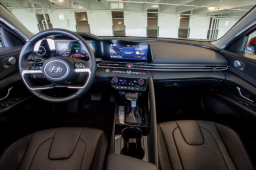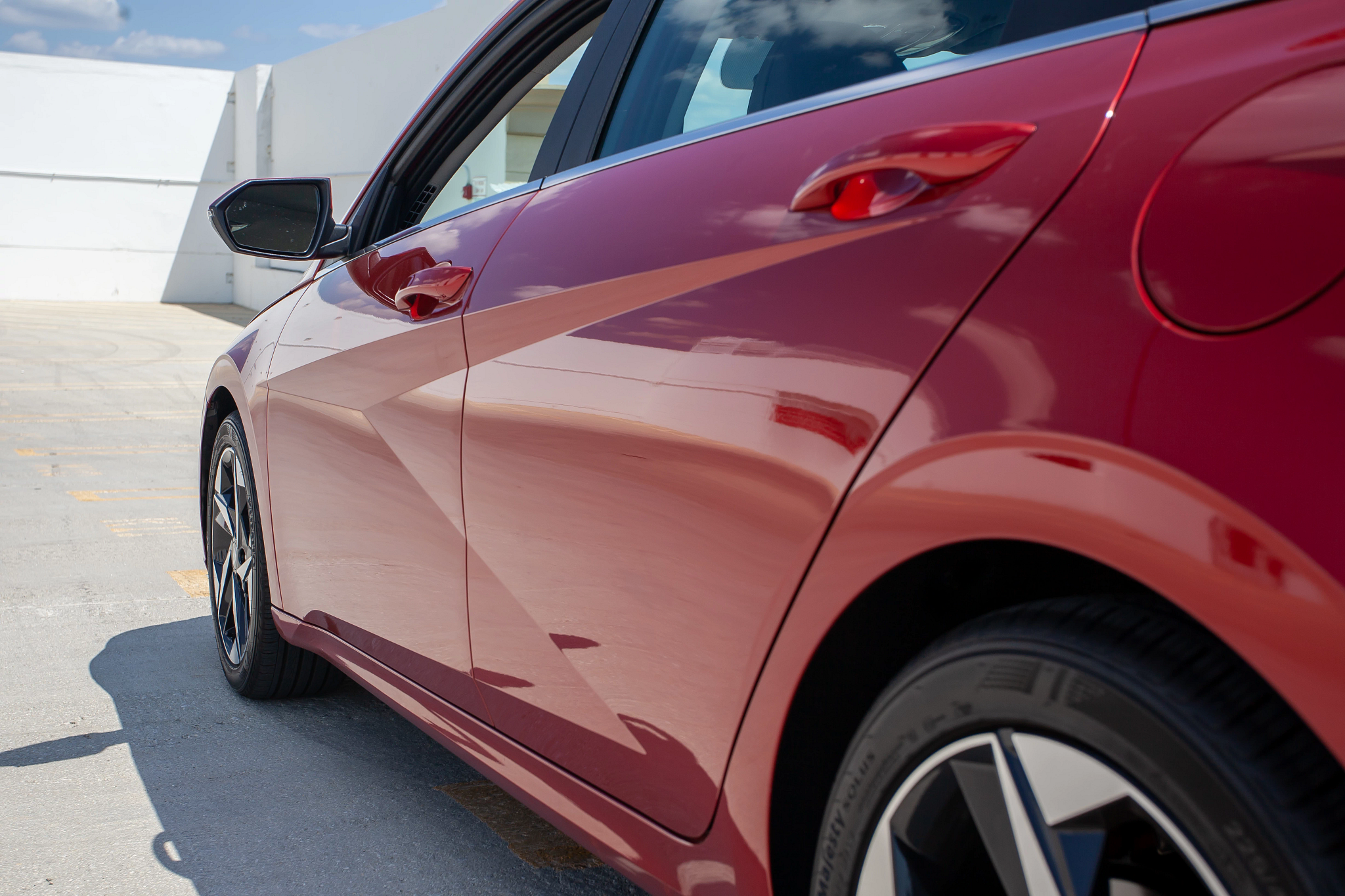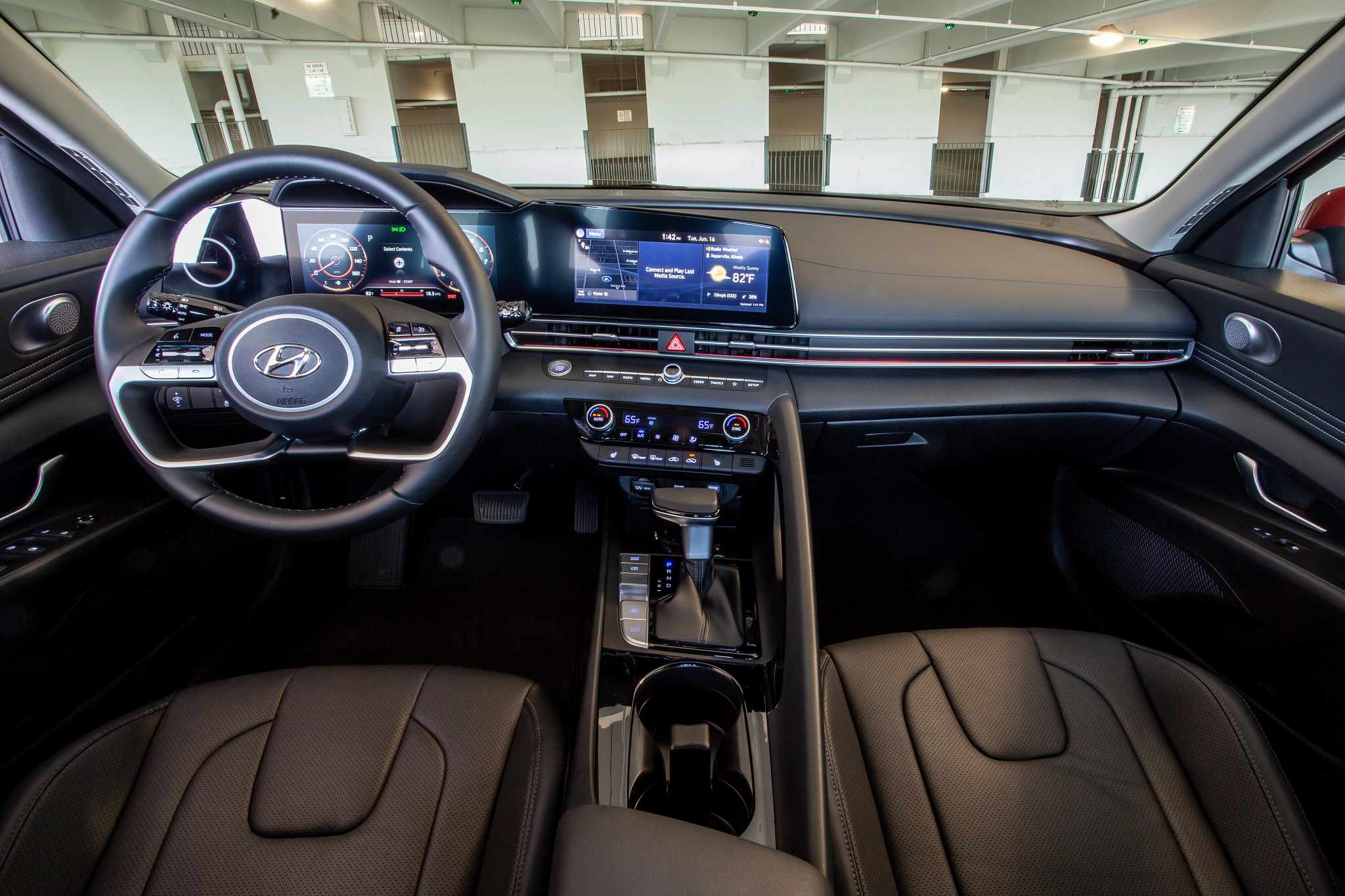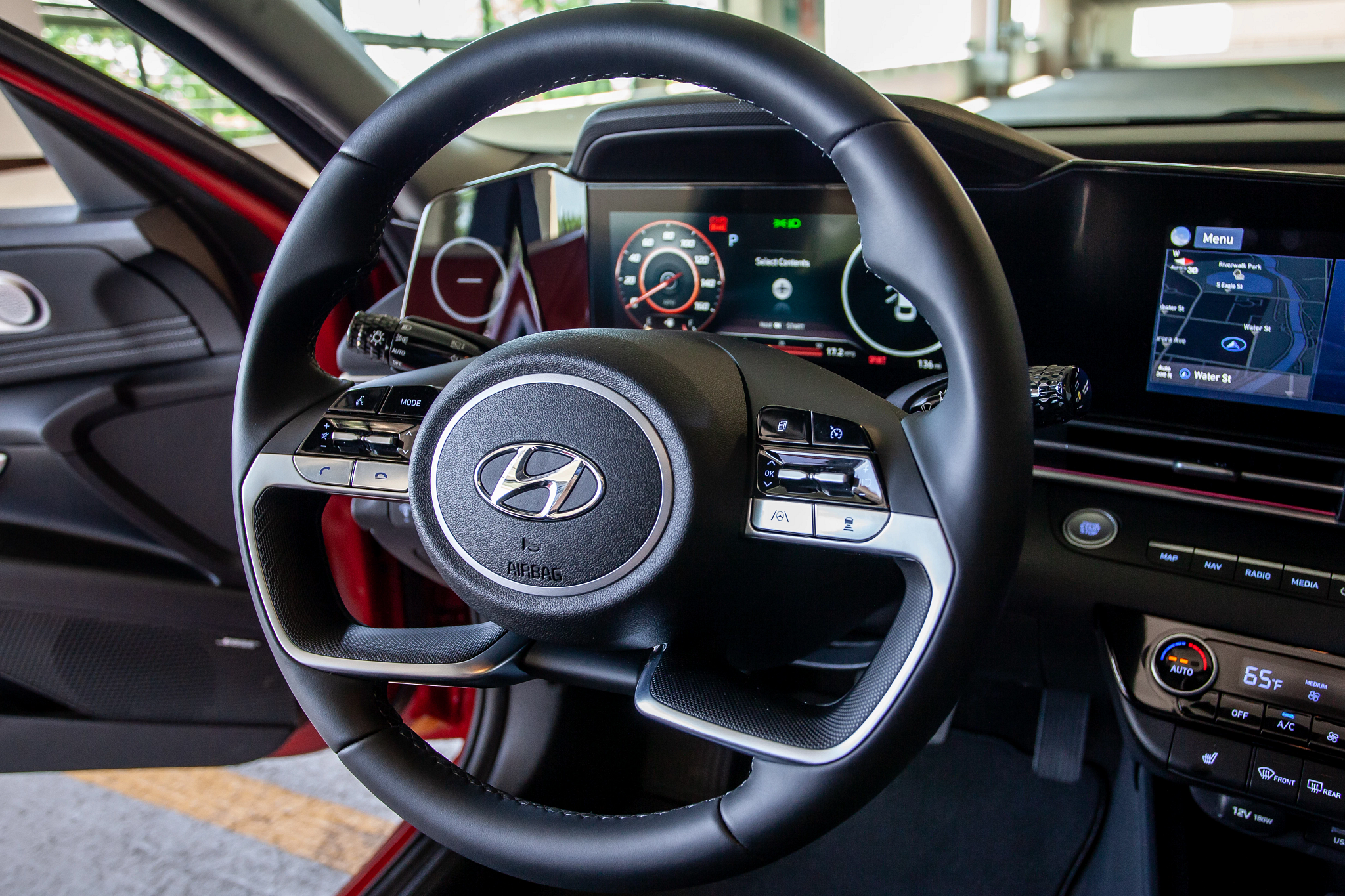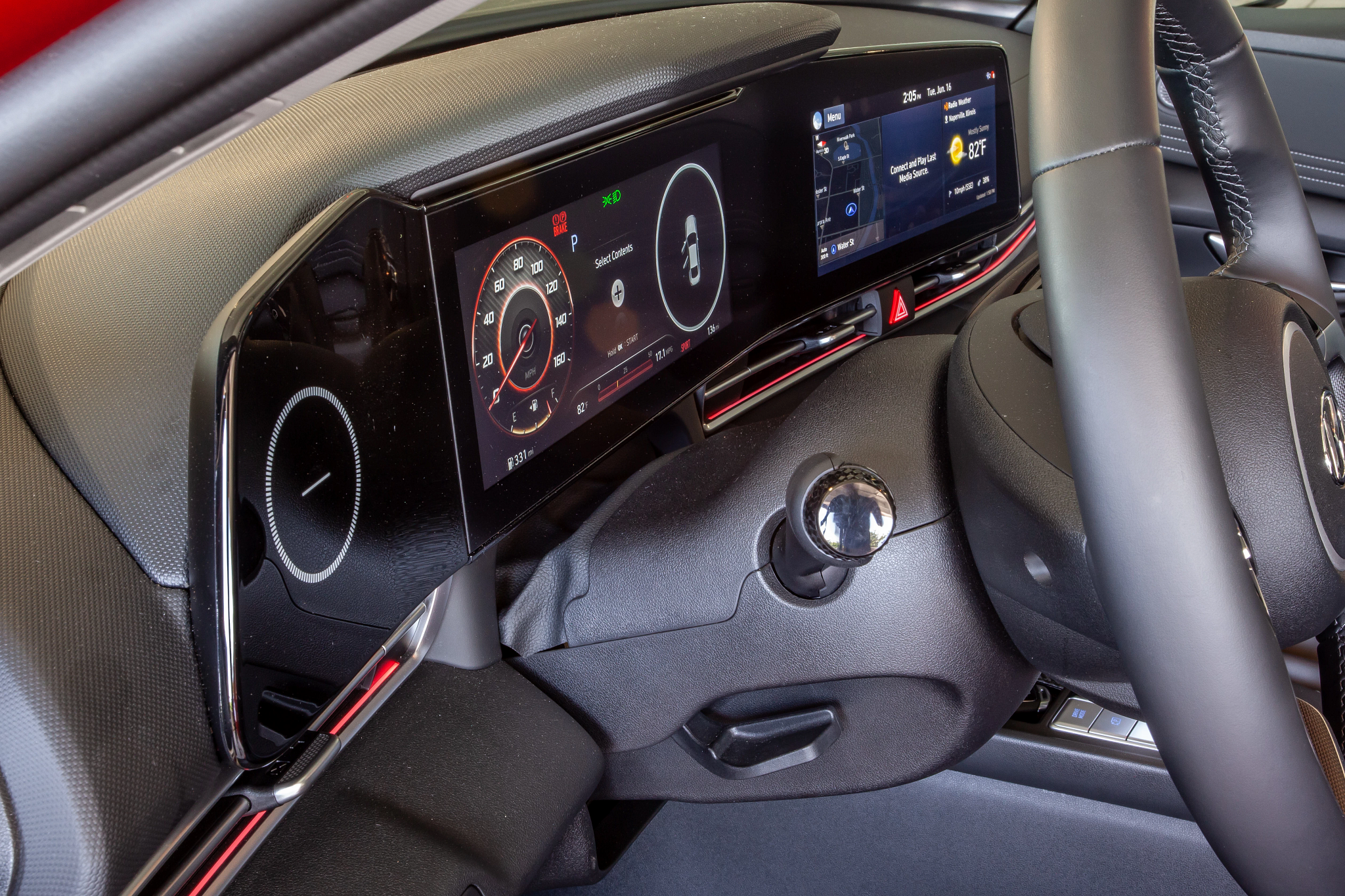Whether you love it or hate it, Hyundai went all-in to make the 2021 Hyundai Elantra a car’s car, with a new sleek shape that’s longer, lower and wider than its predecessor, and a daring design that uses more triangles than a gamer size bag of Doritos. We were introduced to the 2021 Elantra via a live stream reveal, but now I’ve had a chance to see it up close (like we normally would at an auto show) to see how its new design and innovative features compare to the staples of the class, the Honda Civic and Toyota Corolla.
Related: 2021 Hyundai Elantra Brings High Tech, High Style, Hybrid
‘Parametric Dynamics’ Exterior Styling
There are interesting things happening on the outside of the 2021 Elantra. Perhaps most notably, the triangular shapes molded into the profile, which is an uncommon and gutsy design choice. Hyundai’s design inspiration is called “Parametric Dynamics” that purports to be designed “to convey new emotions to customers through geometrically separated beauty.”
Translation: triangles. Lots of triangles. It was actually quite fun to try and count the number of triangles on the car’s exterior, until it wasn’t — there are many. The Elantra has a long profile like the Civic versus the traditional small sedan shape of the Corolla, and it’s longer than both (184.1 inches versus 182.7 for the Civic and 182.3 for the Corolla). It’s a long car, and the design tricks you into thinking the car’s roof is longer than it is by painting part of the rear deck black.
Interior Size and Shape
In the driver’s seat, there’s certainly a sense you’re sitting low in the car, much like the redesigned 2020 Hyundai Sonata. The seating position is lower than the outgoing Elantra, and the interior design uses long, wraparound character lines to make the interior feel wide and low, and like it wraps around you. I was in the top Elantra Limited trim that uses dual 10.25-inch displays for the navigation panel and instrument cluster, and the navigation panel accentuates that effect by being tilted 10 degrees toward the driver. Sitting in the Elantra’s driver’s seat is more like the sporty seating position of the Honda Civic than the comfort setting of the Toyota Corolla or a Volkswagen Jetta.
Bumper to bumper, the 2021 Elantra is 2.2 inches longer than its predecessor, which pays off in backseat legroom that’s grown by a huge 2.3 inches from the previous Elantra — leg comfort is a nonissue in this car. The backseat is plenty roomy, though at 6 feet tall (my length comes in my legs versus torso) I might have been on the upper end of headroom comfort with the top of my hair brushing the top of the interior.
Interior Quality
You won’t find near-luxury materials in this car like you can within the Hyundai family in the Hyundai Palisade, or in the compact sedan class like the Mazda3. I have to give credit, however, because the Limited’s interior doesn’t appear cheap; its design makes the interior look unique enough that, at this price, you might not be concerned about various textured plastic interior pieces.
The lack of opulence was most apparent in the backseat where it’s a barren experience, perhaps exaggerated by my test car’s monochrome coloring. The doors are mostly hard plastic with no soft-touch pad on the elbow armrest or top of the door, which isn’t the norm for the class — and especially not for the top trim levels, which usually have some soft-touch areas for comfort. There’s no DC outlet or USB charge ports for rear passengers like in the redesigned Nissan Sentra.
How much the Elantra costs compared to rivals will be the determining factor in how big of a call-out its interior quality will really be, and we won’t know that until closer to this Hyundai sedan’s fall 2020 on-sale date.
Technology
If the Elantra is luxury-like in any way, it’s because of its tech features. Let’s rewind to those dual screens: It’s wild to see this kind of integration in a compact sedan as opposed to, say, a Mercedes. The dual 10.25-inch screens live under a single piece of glass and feature high-resolution, vibrant graphics. And that circular design flanking the screen? It’s nothing now, just a design, but could be used as something on future variants.
I’ve grown familiar with the center dashboard touchscreen from its use in Cars.com’s long-term Hyundai Palisade test SUV, and it’s just as user friendly here as it is in the Palisade with one exception: The Elantra’s control system has a single volume dial versus the Palisade’s volume and tuning dial. I prefer the dual dials for their more intuitive use while driving, but one dial is still better than no dials (I’m looking at you, 2016-2018 Honda Civic).
What the Elantra does better than the Palisade, though, is the digital instrument cluster. In our Palisade, the digital instrument cluster has animations that change with the drive mode, and their pixelated jerkiness looks like when you have 37 browser tabs open while trying to watch a 4K video. In the Elantra, the animations are smooth and fast, and the full effect comes across when it’s not skipping across the display.
It’s worth noting a few tech features I didn’t get to test, but will be available (mostly) when the car goes on sale later this year. First is wireless Apple CarPlay and Android Auto. Up until this year, only Audi, BMW (and, by association, the Toyota Supra) and Mini had wireless Apple CarPlay and Android Auto; everyone else made you tether to a USB port. The 2021 Elantra gets wireless CarPlay and Android Auto, but oddly, not the top trim level I tested. Only the standard 8-inch-touchscreen cars get wireless functionality, though that may change in future model years.
Also notable is a digital car key function that lets you use your phone as the car key to unlock and start the vehicle — another feature taken straight from luxury cars. Lastly, a new voice-recognition system responds to more casual language and performs such tasks as opening the windows, turning on the heated steering wheel, heated seats or changing the climate control; it’s available, but wasn’t activated on the car I tested.
One low-tech feature that caught my attention was the center-console cupholder, which has adjustable depth for tall bottles or mugs. In one position, the cupholders are shallow for a small to-go coffee cup, but flip the cupholder 180 degrees, and the base lowers deeper into the cupholder cavity to give more depth for a larger water bottle or tall travel coffee mug. This was welcome because the door pockets weren’t wide enough to fit my large water bottle. One annoyance I ran into is that the two cupholders aren’t independently adjustable, so while I had both a coffee and a water with me, I either had a water bottle sitting shallow in the cupholder or a to-go coffee cup being supported by its lid. (I guess I’ll just have to order a larger coffee next time).
More From Cars.com:
- 2021 Hyundai Elantra Angles for Mojo-Recharging Redesign
- 2021 Hyundai Elantra N Line Sedan Teased: Here Are 3 Safe Assumptions
- Best Cheap Sports Cars: Here Are Our Fave 14
- What’s the Best Compact Sedan of 2017?
- 2020 Hyundai Sonata Review: Not Out of the Game
What Else You Need to Know
There’s a bunch that’s new under the hood with a new continuously variable automatic transmission, the stiffer and lighter chassis, and numerous changes aimed to improve how it drives. The base engine is a 147-horsepower, 2.0-liter four-cylinder gas engine making 132 pounds-feet of torque, but there will also be a hybrid variant (139 hp and 195 pounds-feet of torque) and a higher-performance N Line model, both of which receive a multilink rear suspension versus the standard torsion beam rear suspension.
The Elantra is going for sporty and athletic, and the Civic is the gold standard for the class — but we can’t talk about how the 2021 Elantra drives yet, and will be covering that closer to when it goes on sale in the fall.
Cars.com’s Editorial department is your source for automotive news and reviews. In line with Cars.com’s long-standing ethics policy, editors and reviewers don’t accept gifts or free trips from automakers. The Editorial department is independent of Cars.com’s advertising, sales and sponsored content departments.
Source: Read Full Article
